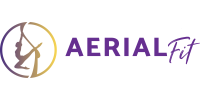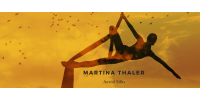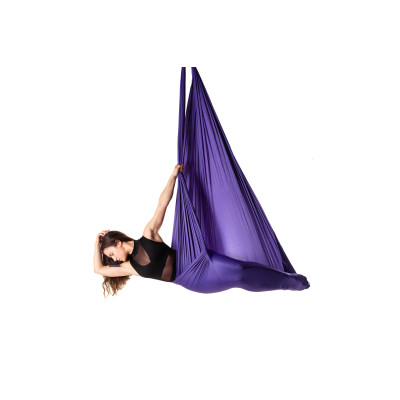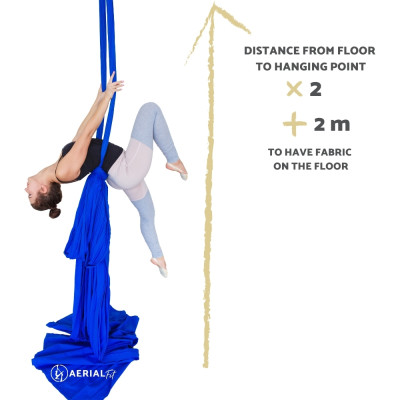1. How did you get started with Aerial sports?
I grew up loving dance and gymnastics. When I was studying dance in college, I saw a picture of a dancer in ropes. That picture planted something in me that grew to a huge desire! I had the unique opportunity to fly across the country to take a workshop in aerial dance at the Aerial Dance Festival held in Boulder, Colorado, where I fell in love with everything that I learned in just one week. From there, I started exploring what I could. This was back in the time before there were any aerial fabric videos on the internet which was actually a real blessing to me in a way. It meant I had only my own sense of creative power to work with, and that opened up world’s that I don’t think I would have found had the internet been feeding (or stifling) my creative powers like it does today.2. You mentioned you have a math background. How did you discover your passion for math and do you think your math background contributed to your current aerial dancing work?
Yes! I love math! I am still discovering the gems of numbers. I love finding patterns in exponential numbers and sequences such as the Fibonacci sequence. My grandpa instilled this love when I was in about 3rd grade. He would also quiz me on my squares, and I remember one day there was a math challenge at school to find all the squares hidden on a checkboard. I quickly saw that the solution involved adding up square numbers because there was 1 big square (8x8), 4 7x7 squares, 9 6x6 squares, etc. I was the only one in class who found the solution and I won my team lots of extra points. Those moments can really define you, and it sure did for me! My math background continues to inform my love for pattern hunting on the silks. I use combinatorics to find the number of entries into certain wraps. In general, I feel the very same part of my brain that loves math at work when I lay out my aerial curriculum, and there’s something that feeds my soul in that.3. How do you currently spend your days? Do you have something new coming up for the Aerial scene?
Well, I just finished up the Aerial Fabric Manual Volume 2, which covers Level 2 (intermediate) fabric. I completely threw out the old books I had previously written on the subject as I now have years of research and input from other aerialists making the curriculum find satisfying completion in its new state. I am excited for the release of this book. It will likely be the biggest book I’ll ever release and it’s the material that most interests me (of course overlapping with what’s coming in Volume 3!). On the coming horizon, I also have the Aerial Sling Manual Volume 2 nearing completion in the outline of the book. I am still conducting research on my students, who--I must say-- love being test subjects for the material! :)
4. I believe it takes a person with great capacity for learning and synthetizing information to write so many great books and to learn and teach like you do. I suspect it has much to do with your mindset being a growth mindset. Do you remember developing such a mindset of growth and perseverance?
It’s funny you mention that because this is a topic I talk a lot about when I conduct teacher trainings. When I was a nuclear physics instructor in the United States Navy, I learned a lot about the philosophies of growth versus fixed mindset. I strongly believe that those who stick out a hobby that is as challenging as aerial can typically attribute their success to having a growth mindset, and our job as teachers is to help foster that mindset as best we can. Those who decide not to pursue aerial even though they want to are often of the fixed mindset that they “can’t do it.” Simply because your body can’t do something today, doesn’t mean that you can’t do it tomorrow. I’m always excited by how much I still have to learn and grow despite how far I’ve come. That process of learning and growing will never end. It is where the excitement is hidden! I like to remind my teachers that the “best teacher is a forever student.” Always be hungry to learn and you will go far.5. Often beginners get discouraged with some fixed ideas. They might think that they need to have a lot of flexibility, strength from the beginning etc. in order to do aerial sports. Is this the case?
You are so right! I often hear “Oh, I could never do that. I have no upper body strength.” And I like to respond, “Of course you don’t! You don’t do aerial!” I say it in a half-joking way, but the truth behind it is that aerialists are not those that were born strong and flexible. They are those who train to be strong and flexible. "You are what you train", I like to say. Anyone can start at any age and go anywhere! Of course, there are limits and our body does put certain restrictions. There are certain levels of strength or contortion my body won’t reach, but the levels that I have reached are far beyond what a “normal” mom in their 40s is doing. This is because I train. I put in the effort and am encouraged by the fact that my body 8 weeks from now is going to be a lot stronger and more flexible than what I am today.6. Can you give some tips on how you get mental clarity, how you focus best?
For me, rest is of utmost importance. I spend Sundays meditating on scripture. Listening to that “still small voice” may make me sound crazy, but it’s what brings mental clarity for me. If I go into a training session and feel heavy or bogged down, I know it won’t go well, and I understand that I need my spiritual bread and water first. Once my soul is fed, my body is typically ready to fly. My dance practice started when I was a young girl, in worship to God. I continue to find great centering in my time with God. After one session of spiritual rest and prayer, I feel lightened, invigorated and ready to fly!7. Did you ever struggle to keep motivating yourself when you encountered challenges in this sport? What helped to overcome them?
I’ve been through two major shoulder injuries that humbled me greatly. It was hard to get through them. In the middle of the injuries I would feel like they were permanent or that I could never return to where I was at. That’s always a scary thought for an athlete. Hearing other people’s stories of recovery was always what encouraged me the most. To hear that other aerialists had “been there, survived that” was always what helped to pull me through. Right now, I’m coming out of recovery of one of those injuries, and I am feeling much better. My lats are extremely sore because they had to take a year off, but I’m definitely back in the swing of things now.8. What are some of the health benefits that you got from practicing Aerial Yoga?
The list is long! I think the older I get, the more I appreciate yoga. It helped me immensely in recovery when I was post-partum, which is now long in the past, but I still have ebbs and flows in my strength and practice. Aerial yoga has always been a great way to find flow, slow me down and it’s meditation in motion. I love the flexibility and stabilizing strength it gives. I find myself feeling energized after a morning of aerial yoga, ready to tackle the rest of the day! I think I get sick a lot less because I do aerial. I am a very healthy person, balanced in so many ways (mental, physical, spiritual) because of aerial.9. What is your most important tip to improve flexibility?
Do isometric stretching!!! An example of isometric is a splits balance on aerial fabric or straps. You can do less extreme variations on the ground to help train for things like this. But the main thing is to press into the stretch. Don’t just relax into it. There is a time and place for passive stretching, but don’t make that the majority of your workout -- only the end. Put some active effort into your stretches and you will see gains more quickly.10. What are some do’s and don’ts for Aerial Fabrics?
Make a consistent training schedule that includes times for hard-core aerial inversion training, flexibility, stabilizer training, cross-training, cardio and rest. Don’t just focus on the “tricks”. Keep up a holistic approach that has a little of everything. You will then not only be able to do your sport well but be able to keep doing it for a long time to come. Thank you for this opportunity to share my thoughts and beliefs. Matthew and I have appreciated our collaboration with SchenkSpass over all these years and look forward to the many more years to come! RebekahAn interview by Sorina Weber, also translated here in German by Julia Rothe
Here you can find some of Rebeka`s best books.















